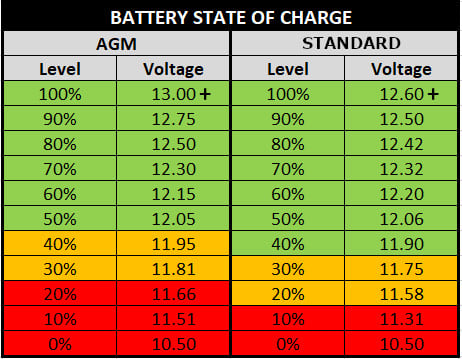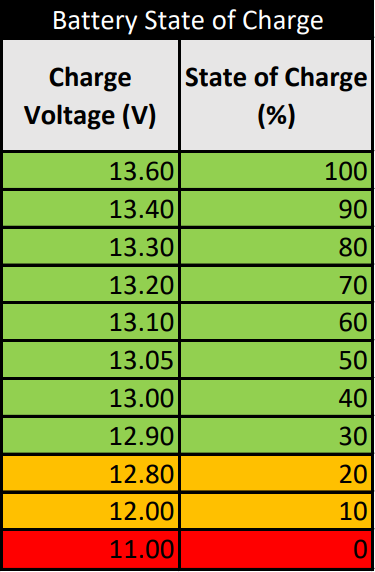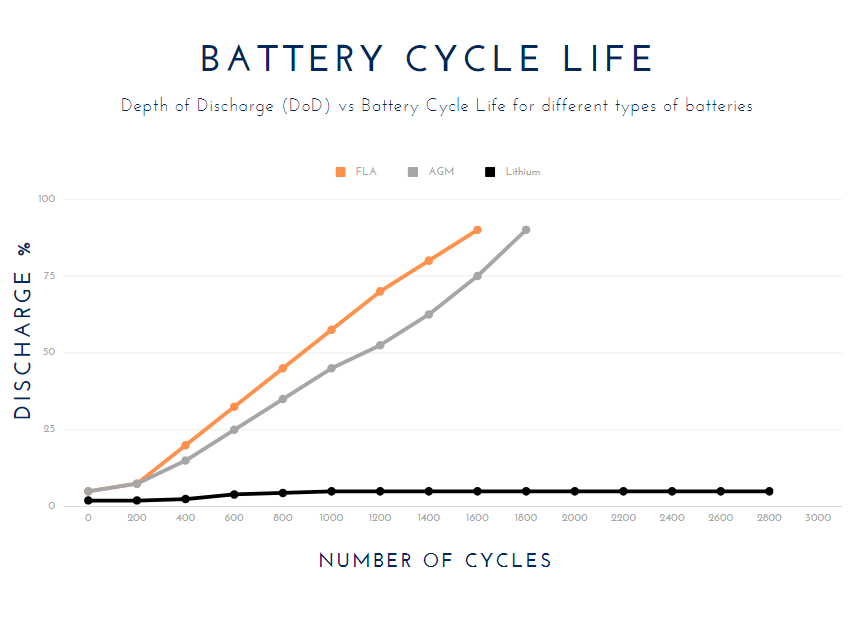Battery Depth of Discharge (DoD) and overall battery life
This article will discuss how much you can use your battery on a daily basis and how this usage affects the battery's long-term lifespan.
Depth of Discharge (DoD)
Depth of Discharge (DoD) is a critical factor to consider when choosing a battery for any application. It refers to the percentage of a battery's total capacity that has been used before it needs to be recharged. Understanding the DoD capabilities of different battery types is crucial for maximizing their lifespan and performance. In this article, we'll delve into the variations in Depth of Discharge between Lead Acid, Absorbent Glass Mat (AGM), and Lithium batteries.
DoD Calculation:
Example: You have used your battery for 1 day of camping and it reads 60% full. You have a current DoD of 40%.
1. Flooded Lead Acid (FLA) Batteries
Lead acid batteries have a DoD range of approximately 50% to 80%. This means that, for optimal lifespan and performance, it's recommended to avoid discharging them below 50% of their total capacity. Going below this threshold can lead to accelerated degradation and a reduced number of charge-discharge cycles.
2. AGM Batteries (Absorbent Glass Mat)
AGM batteries offer a DoD range of approximately 50% to 80%, similar to traditional lead acid batteries above. This means they share the same considerations regarding avoiding deep discharges for prolonged battery life.

Voltage should be read with no load on the battery
3. Lithium Batteries
Lithium batteries, depending on the specific chemistry (such as lithium-ion or lithium iron phosphate), can offer an impressive DoD range ranging from 80% to 95%. It is recommended to never fully discharge a lithium battery as this can damage the cells contained within the battery. This means compared to Lead Acid or AGM batteries they can be safely discharged to lower levels without compromising their lifespan or performance. It should be noted that the voltage range of the Lithium batteries is very narrow and even small changes can represent a large change in battery use. Below is a table with Voltage and State of Charge values for a lithium battery.

Voltage should be read with no load on the battery
Battery Cycle Life
Caution! Never completely discharge a battery to 0% no matter the chemistry

Above is an example graph to help understand battery cycle life concept and the affect DoD has on battery longevity.
Example 1: If a FLA battery is always discharged to only 90% full, one could expect to get 1500+ cycles, however if that drops to 50% it be must less than 800 cycles
One of the main benefits to Lithium batteries is that they are incredibly robust in regards to DoD and battery life cycle. This means you get more useable power for the same size battery and it will last longer.
Example 2: A Lithium battery can be discharged to only 5% full and still maintain its full life cycle rating.
Conclusion
In summary, Depth of Discharge (DoD) is an important factor in battery selection, where lifespan and performance can vary greatly. Lead Acid and AGM batteries exhibit a DoD range of 50% to 80%, emphasizing the need for cautious discharge levels. Lithium batteries, boasting a range of 90% to 95%, provide exceptional flexibility without compromising longevity. Moreover, their robustness in battery cycle life sets them apart, offering greater efficiency and usability over their lifetime.
![OGT logo-2.png]](https://support.offgridtrailers.com/hs-fs/hubfs/OGT%20logo-2.png?height=50&name=OGT%20logo-2.png)